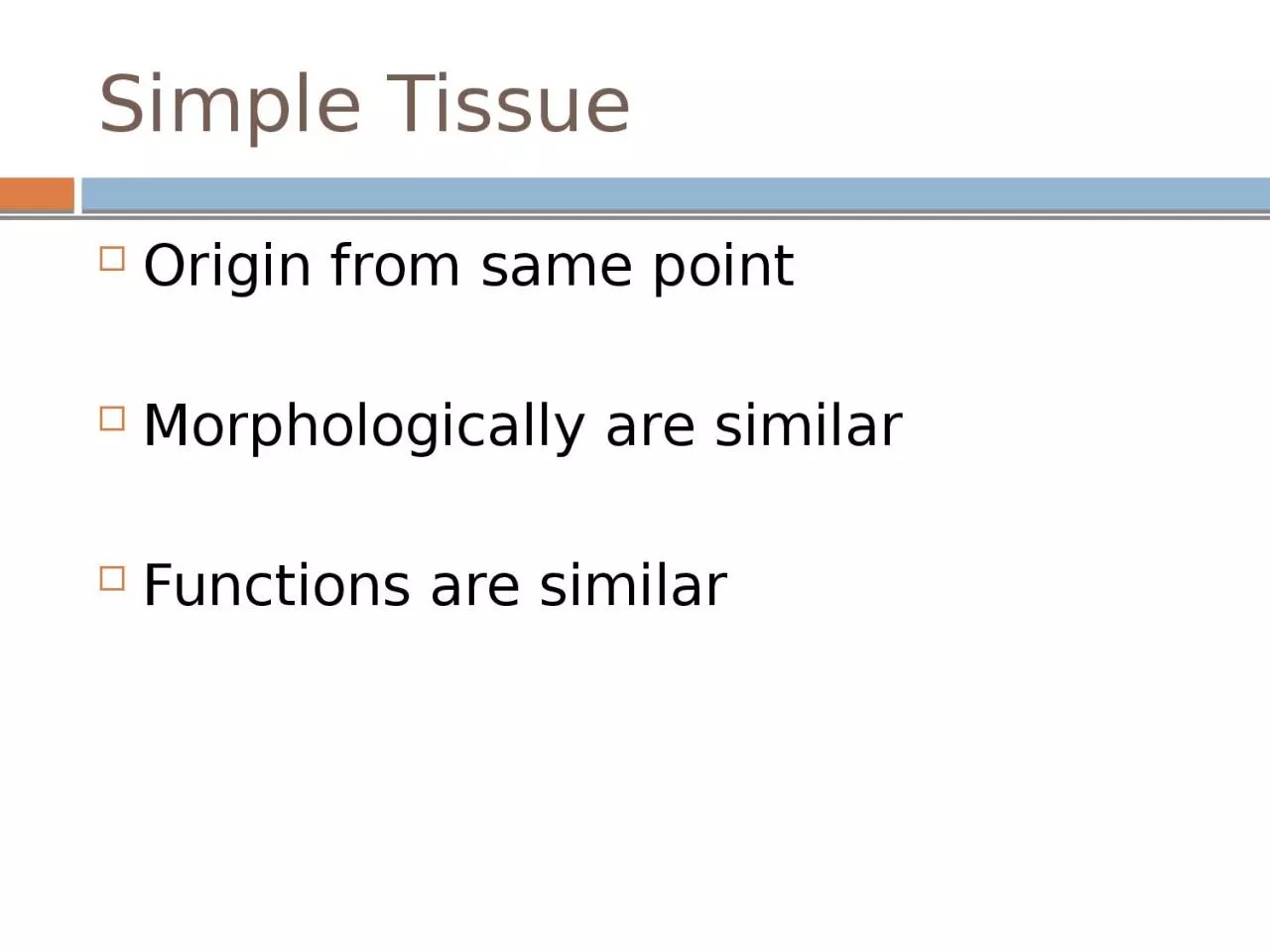

Morphologically are similar Functions are similar Types of Simple Tissue Parenchyma Collenchyma Sclerenchyma Parenchyma They are living cells Cell wall thin which is composed of cellulose Individual cell is known as parenchyma cell ID: 1010802
Download Presentation The PPT/PDF document "Simple Tissue Origin from same point" is the property of its rightful owner. Permission is granted to download and print the materials on this web site for personal, non-commercial use only, and to display it on your personal computer provided you do not modify the materials and that you retain all copyright notices contained in the materials. By downloading content from our website, you accept the terms of this agreement.
1. Simple TissueOrigin from same pointMorphologically are similarFunctions are similar
2. Types of Simple TissueParenchymaCollenchymaSclerenchyma
3. ParenchymaThey are living cellsCell wall thin which is composed of celluloseIndividual cell is known as parenchyma cellThey may be oval, round or polygonalNucleus is conspicuous and largeDo physiological function
4. Origin of parenchyma tissuePrimary meristemGround meristemProcambiumCambiumCork cambium
5. LocationEpidermisCortexPithIn vascular bundle as xylem parenchyma and phloem parenchymaCambium (fascicular and cork cambium)
6.
7.
8.
9.
10. Types of parenchymaChlorenchymaAerenchymaIdioblastProsenchyma
11. FunctionsDo physiological functions viz. photosynthesis, respiration and other metabolic activitiesHelp in floating as in hydrophyteStore food material
12. Collenchyma TissueLiving tissueMore or less elongated thick cell wall with non lignified Cell wall composed of cellulose and hemicellulose
13.
14.
15. Origin of Collenchyma tissuePrimary meristemGround meristemProcambiumCambiumCork cambium
16. LocationHypodermisCortexBundle cap
17. Type of CollenchymaAngular- Thickenings are primarily at the corner or angular positionLacunar or tubular collenchyma- Thickennings are restricted to the walls of the regions bordering air spacePlate or Lamellar collenchyma- Thickennings occur chiefly on the tangential walls and lesser in the radial walls. As a result, cells appear like plates.
18.
19. Location or DistributionFound in hypodermisBoth sides of the vascular bundle in leavesSome time in bundle cap
20. FunctionsEffective mechanical tissueProvide tensile strength to the growing organs during developmentProtect VB of leaves by forming bundle sheathDo physiological activities like photosynthesis
21. Sclerenchyma TissueHard tissueNon-livingCell walls are very thick having lignin
22. OriginProcambiumCambiumSome time ground meristem
23. TypeFiberSclereidsFibers are two types- Xylary and extra xylary
24. Xylary FiberLibriform- very thick secondary wall havingsimple pitsFiber tracheid-Relatively thin wall and bordered pit
25. Distribution
26. FunctionsMechanical strengthConduction of water and minerals
27. SclereidsNon presnchymatousCommonly called stone cell
28. TypesBrachysclereids (stone cell) –short roughly isodiametric sclereids found in cortex, pith, phloem and some time flesh of fruitMacrosclereids-Elongated columner e.g. seed coat of legumeOsteosclereids-Bone or barrel shaped commonly found in seed coates of several monocotsAstrosclereids-These are star shaped found in leaves of NympheaTrichosclereids-Hair like found in aerial roots and leaves of olive
29.
30.
31.
32.
33.